If you have decided to start keeping bees, you have probably done a lot of research about beekeeping, techniques, and the equipment you need to start. There are, however, some other things to consider before you start your new hobby or business. These factors led me to the question, how much land do I need to keep bees?
A typical hive grows in a 16 by 22-inch vertical tower and more if it is a Top Bar. The general rule of beekeeping is that you need at least a 5ft clearance of free space in all directions for each hive you have. It is best to check local bylaws as the space you need might be influenced by laws.
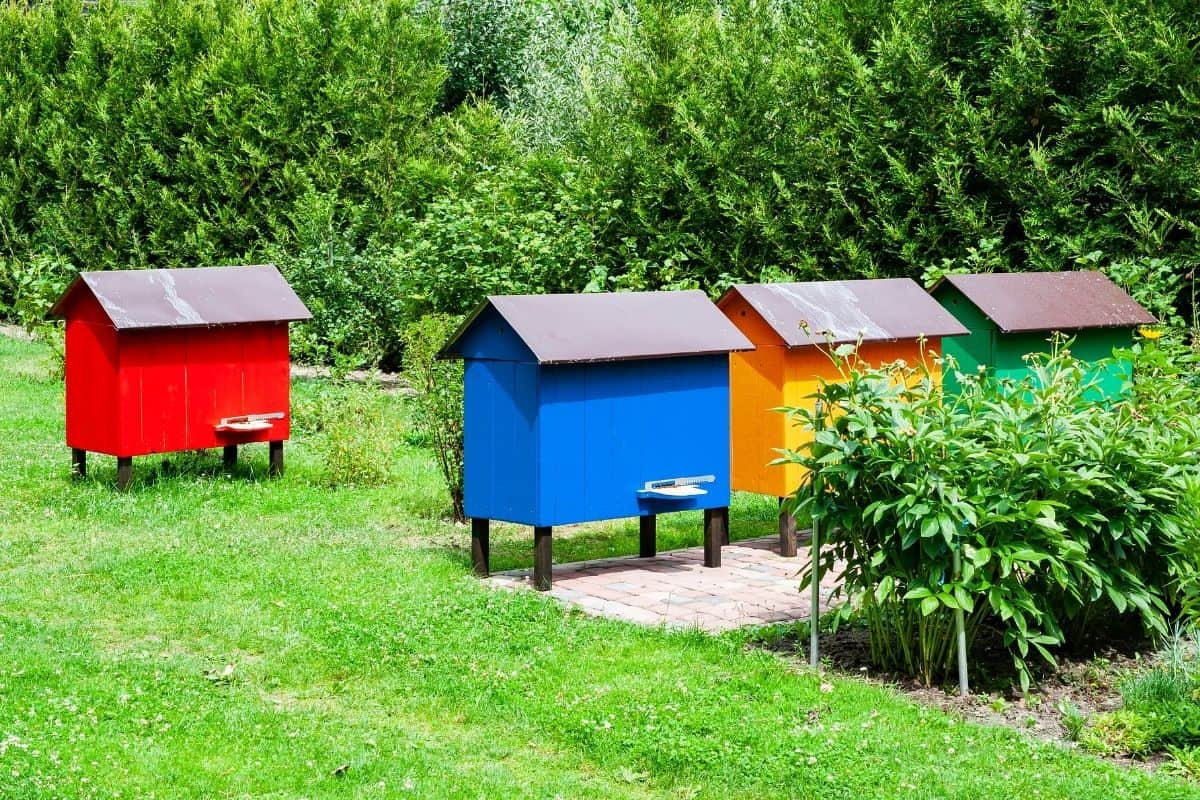
When I started looking into getting some bees a few years ago, I learned that bees need enough space in order to thrive. Here’s what I found out in my research.
4 Things To Consider Before Getting Bees For Your Backyard
There is some debate about the size of the property when you keep bees due to different bylaws in some counties. Here are some things you need to think about regarding the size of land you need to keep bees.
Have questions about beekeeping? These beekeeping books for beginners are your best friend in your bee learning journey.
1. Safety
When deciding how much land you need to keep bees, you must consider how much foot traffic will go through the beehive space every day. It would be best to keep the beehive entrance away from any human traffic, as bees come and go all day, and they should be left alone as much as possible.
2. County laws and regulations
Different counties have different laws and bylaws about the space you need to have to keep bees. You can find out what the law and regulations say about the size of land you need and if Homeowners associations are in charge of beekeeping bylaws.
Some Homeowners associations ban beekeeping altogether; others require that your apiary must be a certain amount of feet away from your neighbor’s fence. That’s why it’s vital to check the law in your town about beekeeping and the space it requires.
3. Neighbors
It’s essential to keep your neighbors in mind when you want to keep bees; some might love the idea, and others might not like the idea that there will be thousands of bees in the area.
There might also be some people in your neighborhood who are allergic to bees, and it might influence the size of space you need and the number of hives you keep.
4. The amount of sunlight your apiary will get
The most common issue for bees is small hive beetles. It is best to put the hive in a place that gets at least 6 hours of direct sunlight as this keeps the beetles away and signals the bees that they need to forage.
How Much Land Do I Need To Keep Bees?
When you have taken all considerations into account, a typical beehive is 2.5 square feet in size and needs at least a 5ft clearance of free space in all directions, either between each hive or around the hive you will put up.
On average, the consensus on land size is that you can successfully keep bees on 1 to 2-acre land. It is a perfect size not only to keep bees, but it keeps you and your neighbors a safe distance from an active hive, and there are fewer human interruptions for the bees to contend with and less foot traffic to disturb the bees.
Learn more about which direction a beehive should face.
Can I Just Get One Beehive If My Backyard Is Small?
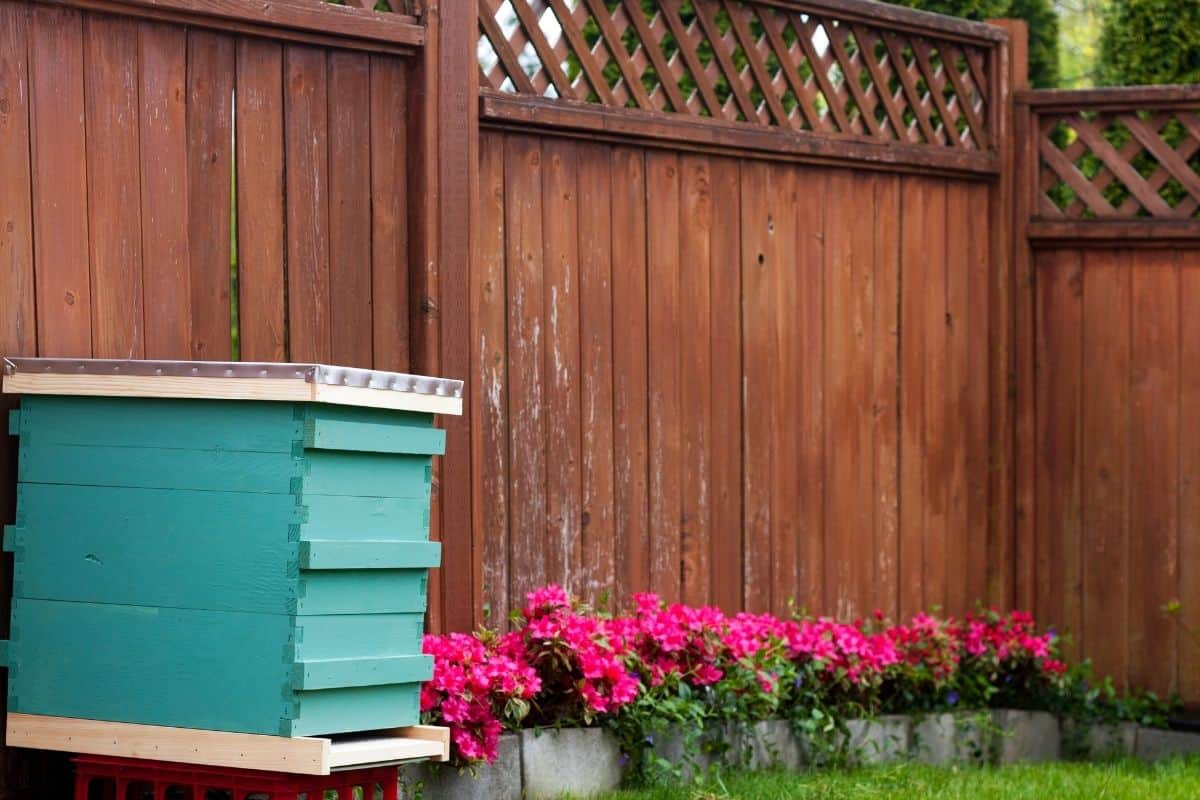
While most beekeepers have between one and four hives, having only one beehive in your backyard is perfectly fine. More beehives do require extra work, time, and money. Ensuring the hive is as far away from foot traffic will be easier if you only have one hive to worry about and tend to.
It would be helpful to keep in mind that a typical beehive starts around 10 inches tall, but a healthy beehive grows quickly and will need extra boxes during peak season.
A hive will forage for 8000 acres. Bees need multiple sources of flowers to sustain healthy hive growth and honey production, so you can be assured that if you have followed the laws of your county and your neighbors are ok with bees, you can safely have one hive.
5 Tips For Beekeeping In Small Spaces
If you want to keep bees but have a small yard in an urban area, have no fear: here are some tips to help you navigate keeping bees in small outdoor spaces.
1. Choosing the right location
When you are limited on space and in an urban environment, you need to place your hive away from any human activities (foot traffic). Bees usually stick to flying the path that the hive entrance is facing. Keeping the entrance away from your neighbor’s pool or compost area is a very good idea because when bees start to forage, it might irritate some people.
Alternatively, a lot of people have great success in placing their hives on rooftops. It gives the bees free reign without you worrying about your neighbor, and it gives you more space to maneuver when collecting honey or checking on your hive.
It also creates a stress-free space for the bees, gives them plenty of sun during the day, and keeps their flight plan open with no distractions or interruptions.
2. Keep an eye out for night lights from your neighbors
As odd as it may seem, your neighbors’ bright night lights or spotlights can be a huge issue with your bees. If your beehive entrance faces your or your neighbors’ night lights, it could be a big problem.
Bees are attracted to light, and this could have your guard bees flying off, circling till morning, and eventually dying from exhaustion.
Avoid this from happening by picking a location facing away from bright lights and as far away from your neighbors’ yard as you can.
3. Have a healthy source of water for your bees
One of the most significant issues that a lot of people have is with a water source. Some of your neighbors might have pools or ponds, which means high bee activity in their yard. Bees need water to drink and to cool down. They will coat the larva cells with a thin coating of water that evaporates, and this creates a mini aircon in the hive.
To keep your neighbors, yourself, and your buzzing friends happy, you can invest in a bee watering station or create one yourself. What you need to do is to take a shallow dish, put rocks or pebbles with a flat surface in the plate, and put water inside.
Remember to only fill it halfway up the rocks or pebbles as bees easily drown, and the stones will serve as a landing platform to the bees.
4. Ensure you have enough working space
You need to give yourself enough space in all directions of your beehive to work. If you need to check on the hive or collect honey, the last thing you want is to be in the flight path of a hive of bees.
You can do this by creating a flat working area for yourself of at least 5-5.5 square feet of space. You will be happy that you made this decision once peak season starts.
5. Talk to your neighbors about pesticides
Even though many of us don’t like to intrude on our neighbors, the one thing that can destroy the whole hive of bees is pesticides.
Because bees travel thousands of acres to forage for flowers, talking to and educating your neighbors on the importance of bee pollination and how pesticides will kill not only the bugs that are a nuisance to their garden but also the bees that pollinate their flowers.
Suggest other bee-friendly ways to eliminate the bugs that plague their garden but won’t kill your fuzzy new friends.
Keeping Bees On Big Plots Of Land
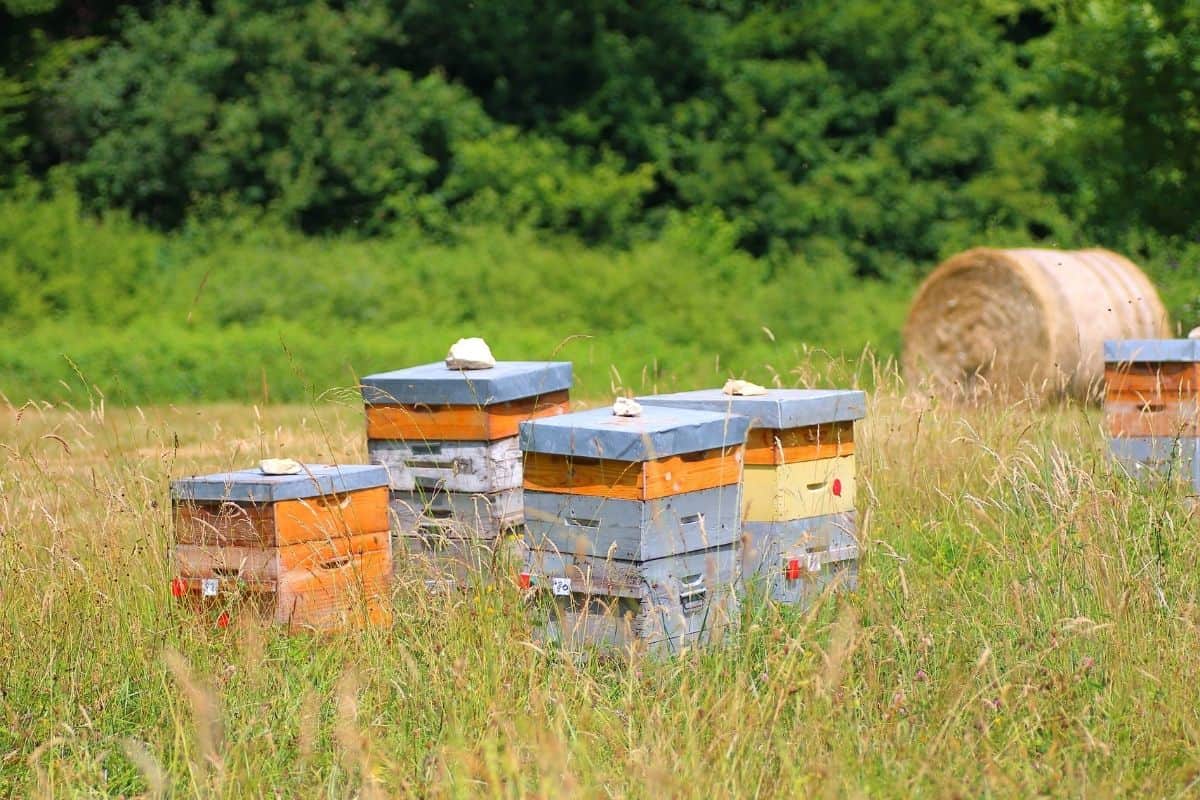
If you have access to acres of land to keep your bees on, chances are you won’t have a lot of issues with your neighbors. You still need to talk to the ones nearest to you.
Your neighbors can be your ally or an enemy, so it would be best to keep open lines of communication and mutual respect between you and your neighbors.
Even if you don’t have issues with your neighbors, there are, however, other factors to consider when you have significant areas to keep bees on.
When you have big plots of land to keep bees, it is crucial to know how many hives you can put and how many flowers, plants, and trees will be sufficient to keep your bees thriving.
Here are some things to keep in mind:
Seasonal changes
Bees are most active in the summer months, and they need a lot of nectar and pollen. It’s for this reason that many beekeepers will only keep a few hives per acre of land. The bees need all the flowers they can get in order to keep the hive growing and healthy.
You can help your bees by not mowing the natural wildflowers near the hive to give them more variety in nectar and pollen. You can also plant winter flowers to help keep them fed during the colder months.
Because bees will forage thousands of acres to find food if it is scarce, you can plant in different sections of your land and not all in one place. It will also urge the bees not to travel too far away from the hive as they have plenty of food.
Choosing the right location for beehives on acres of land
When choosing the perfect site to place your beehives, there are a few tips that will help you to make this decision easier:
- Choose a southeast-facing direction for your beehives, it gives them early morning sunlight, and they get an earlier start to their day.
- Choose a place not too far away for you to carry honey and equipment to and from your house to your apiary. It will save you time and energy.
- Help your bees avoid too much wind by building a vine fence at the back of your hives or flowerbeds that grow high enough to keep the wind at bay.
- Place your hive on dry, hard, and level soil to avoid it toppling over in severe storms or sinking into mud when it rains.
Provide a source of clean water for your bees
No matter the size of land you want beehives on, you need to ensure that the bees have a good water source. Bees need water that is fresh and clean, and this could be tricky on big plots of land, If you’re lucky enough to have a small stream, it is advisable to place the hive next to the stream.
If you don’t have one or the other factors are a problem, you can still have a watering station, just on a bigger scale, keeping in mind that it needs to stay shallow.
Be aware of neighboring crops
When keeping bees on big plots of land, the chances are that there are farmers or neighbors with vegetable gardens in the area, and they might use pesticides.
As discussed earlier, pesticides are a considerable hazard to bees and can kill a hive in no time. It’s crucial to talk to your neighbors about this and check if they use bee-friendly natural repellents or deadly chemical pesticides.
Talk to them, and you may find bee buddies and fellow bee enthusiasts that will help keep your bees safe, and you can treat them to some honey in the summertime.
Conclusion
Keeping bees can be a great source of joy, and honey, don’t forget the honey. While it might not be easy in the beginning to get it all set up, it is well worth the time and money in the end. Whether you keep bees in urban areas or big pieces of land, you will learn to love the fuzzy flyers.
Remember always to chat with your neighbors; happy neighbors can make your life much easier; give yourself and your bees enough space to work in, and always have enough water to help keep your bees hydrated and cool.
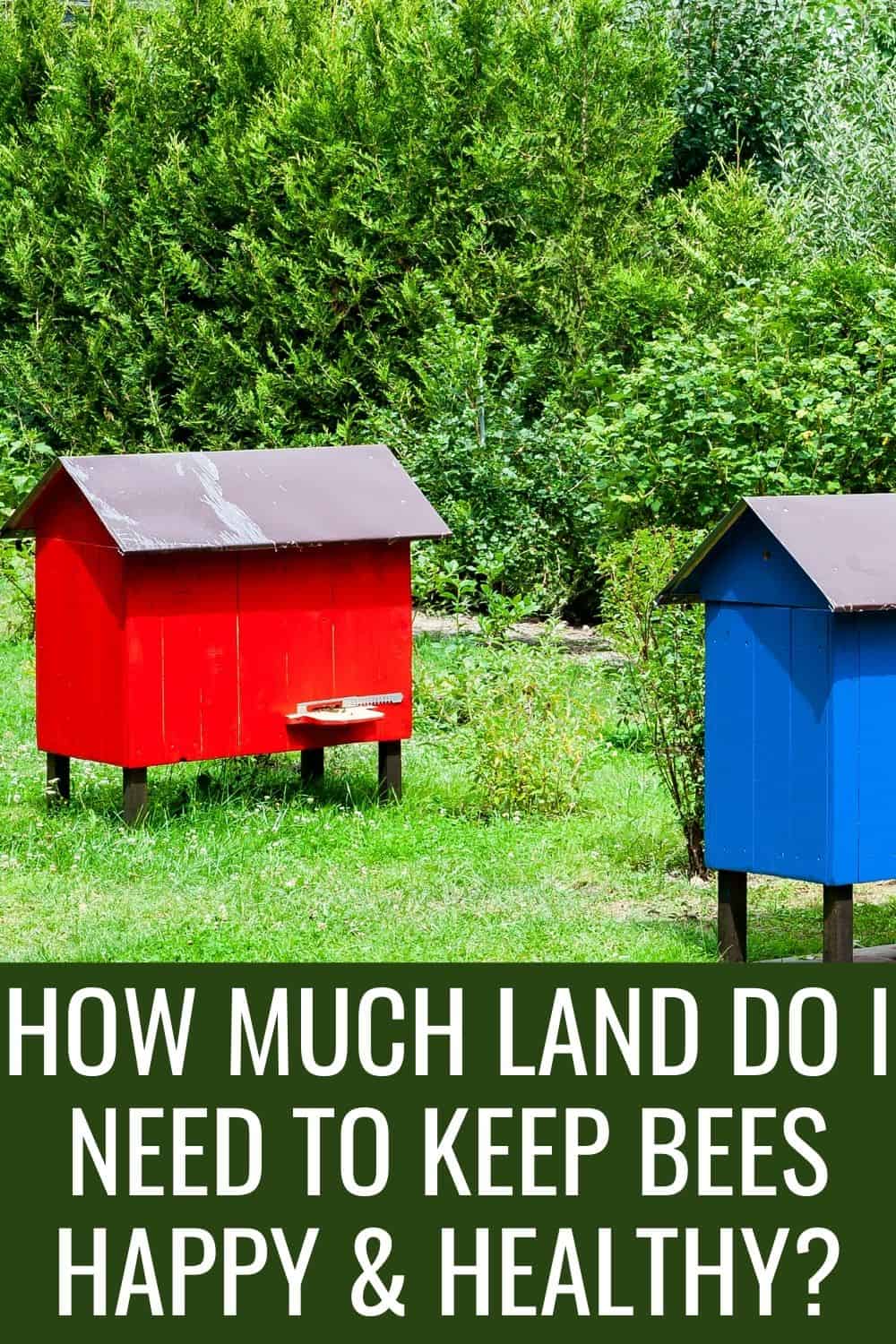

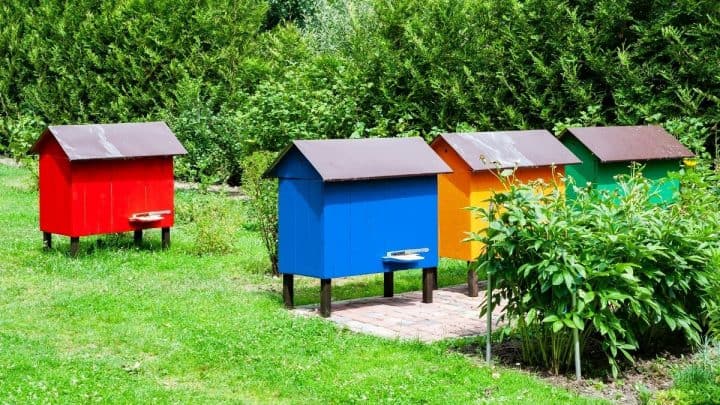

Quick Introduction To Beekeeping
Thursday 10th of November 2022
[…] How Much Land Do I Need to Keep Bees Happy & Healthy? […]